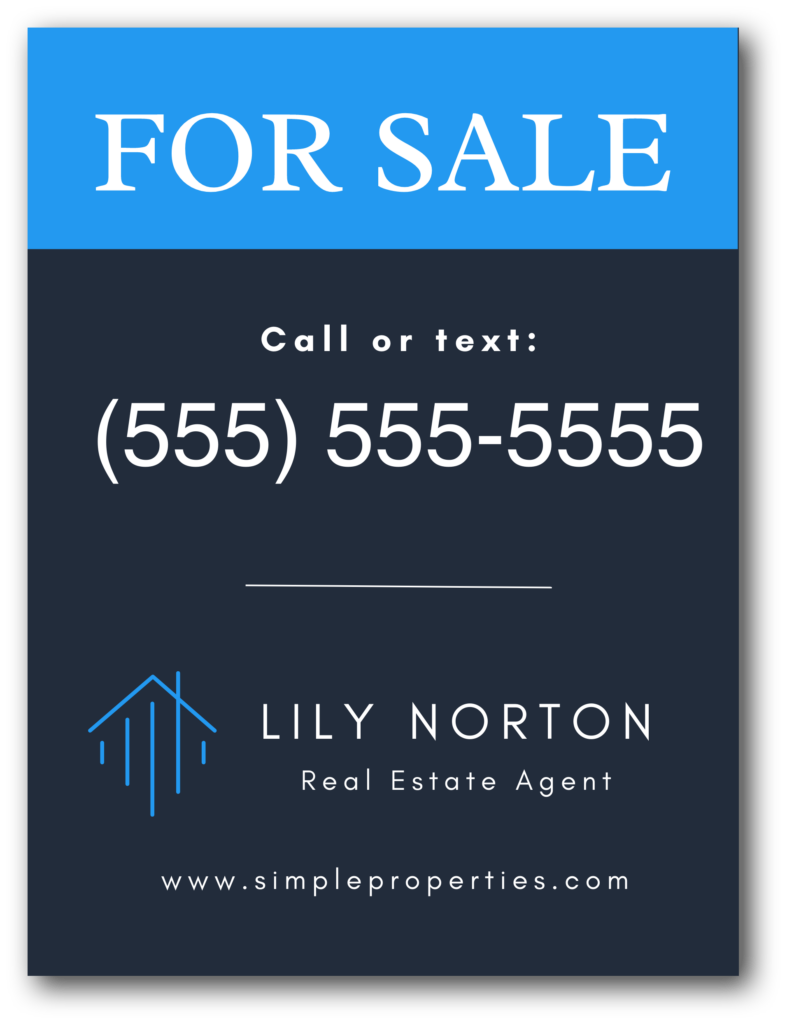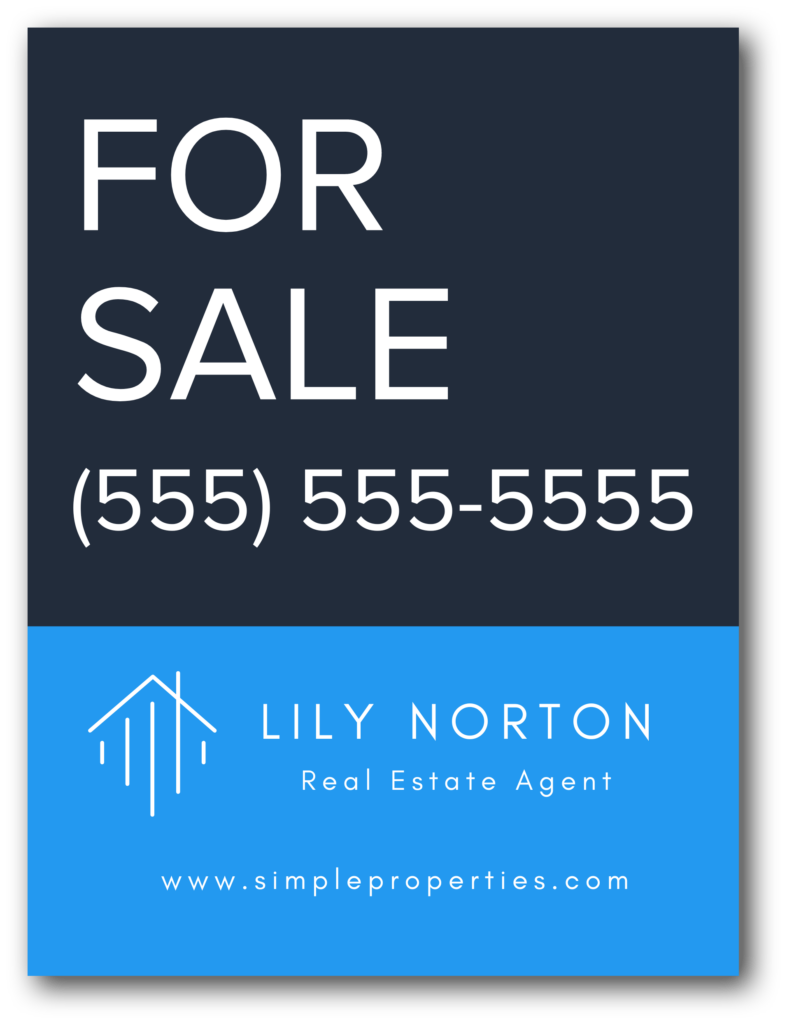What the best real estate riders have in common
Create real estate sale signs and riders that drive more sales with these tips.
As a real estate agent with a juicy house listing (or twelve) to show off, you face one big challenge: How do you attract attention and make your listing(s) stand out among the thousands of others on the market?
You’ve probably already got your listing up on Zillow and/or Trulia, which is excellent. But don’t sleep on the secret weapon that is the old-fashioned real estate “for sale” sign.
Of course, if you’re going to use a sign you’ll need to figure out what to include on it, how it should look, and where you’ll get it from in the first place. I’ll cover all that and more here.
Do real estate for sale signs even work?
Let’s address the elephant in the room: Obviously, most people look for house listings online. Around 97% as of 2020, if we’re being exact.
Don’t let that get you down, though. For sale signs still have a lot to lend to your real estate business.

I found several accounts from real-life agents who rely on physical signs for a few key reasons.
- They promote word of mouth. As one real estate agent put it, “People who weren’t even looking buy houses all the time. Neighbors who see signs tell their friends about houses all the time. Signs still work, they capture the eyes of people who don’t live on Zillow.”
- They help promote you, the real estate agent. Others claim that even if you don’t make a sale from the sign itself, it will still call attention to your name, which may be useful next time viewers need a real estate agent.
- They give local buyers an edge. Yet one more real estate agent reported that, on a listing of theirs, “We had 20+ inquiries based on our “Coming Soon” sign well before we even listed…People would go to an open house in our neighborhood a few weeks before ours, see our sign on their drive, and instantly call our agent to try to get an in on our house.”
What info should you include on a real estate yard sign?
Most people who will read your sign are on the move, either walking or driving. That means you only have a few seconds to make an impression. Don’t waste any space with information that isn’t essential.

Be sure to include:
- Your logo (or your brokerage’s logo)
- Your name and number
- Your contact information
That’s it. Just three key pieces of information are all you need. Remember, you’re here to sell the house, so save your headshot for your website instead.
What makes a good for sale sign design?
You could spend hours looking at real estate sign templates. It can be a bit overwhelming at first. What color should you go with? All caps or no caps? 12″ by 18″ or 18″ by 24″?
I get it. There are a lot of options out there, and you want to make sure your sign is eye-catching. Understanding a few key design principles will help.
- Chose an easy-to-read font. You want viewers to be able to read your sign at a glance and potentially from a distance while driving. Make sure your font is large enough, and leave the cursive script alone.
- The fewer colors, the better (otherwise, your sign may get a little difficult to look at). Don’t overwhelm viewers or confuse their eyes. Stick to two or three main brand colors that pair well together.
- Pick a font color that stands out against the background. This, again, is in the name of readability. You want your sign to look pretty, but it should also send a clear message to the reader.
- Make your phone number prominent on the sign. Obviously, the end goal is to get interested buyers to call about the home. Make sure they know how to get in touch with you.

Not to mention, there are plenty of template creation sites out there to help you craft a sign customized to your needs and preferences.
Lots of Etsy vendors offer custom real estate signs as well as Custom Real Estate Signs, Vistaprint, and on and on. If you’re extra crafty, you can design your own signs on Canva.
Psssst…One real estate agent I heard from suggested asking your fellow agents where they get their signs made. They’ve likely done their research and can tell you who in town has the best rates for signage printing.
Real estate for sale sign FAQs
What size are most real estate signs?
It depends on which format you go with, but here’s a quick guide to some of the most common sizes.
- H-frames, Frames, and A-frame boards: All these signs usually come in 24”x18”.
- Colonial Posts: These tend to be 28.8″ x 55.5″ x 1.0″, although they can sometimes be up to 30” wide across both the rider and the sign.
- Feather Flags: Feather flag signs can vary a little more widely, but they often come in 6’ or 8’ sizes, although you can buy larger flags up to 17’.
- Vinyl Window Signs: These really are dealer’s choice, as you can order custom window cling signs from 12”x12” up through 52”x100”.
Where should you place your real estate sign?
Once you have your sign printed, it’s time to find the right spot for it.
This may sound like common sense, but sometimes it can be hard to tell if a sign is hidden from a certain angle. Be sure to drive and walk by the property from all sides to make sure your sign is properly positioned.
If the home you’re selling is on a street that doesn’t receive much foot traffic, print out a few extra signs and place them at nearby streets and intersections.
These should include the address of the home, just in case people drive by and want to visit later. Some homeowner associations have rules regarding sign placement, so be sure to check with your local HOA first.
What are most real estate signs made of?
Again, this mostly depends on the format you decide to go with and how durable you’d like it to be.
A lot of colonial posts, for example, have frames made of wood. H-frames and frames, on the other hand, are typically metal but could be PVC.
Feather flags tend to be polyester fabric and A-frame boards could be aluminum, wood, plastic, or chalkboard.
What makes a great real estate sign?
The best real estate signs are eye-catching, clear in their purpose, and lead interested buyers to you.
That means your sign needs to state that you’re representing a house for sale, let readers know how to get in touch with you, and look attractive and professional.
The best real estate signs make your work easier
A successful real estate for sale sign is like having an assistant who does your busy work for you.
By ensuring you have for sale signs with good design, proper information, solid placement, and the power of text message auto-replies, you’re setting yourself up to sell more homes than ever.
This article was published on April 30, 2019, and was updated on April 6, 2023, by Lily Norton. Dani Henion contributed to this piece.